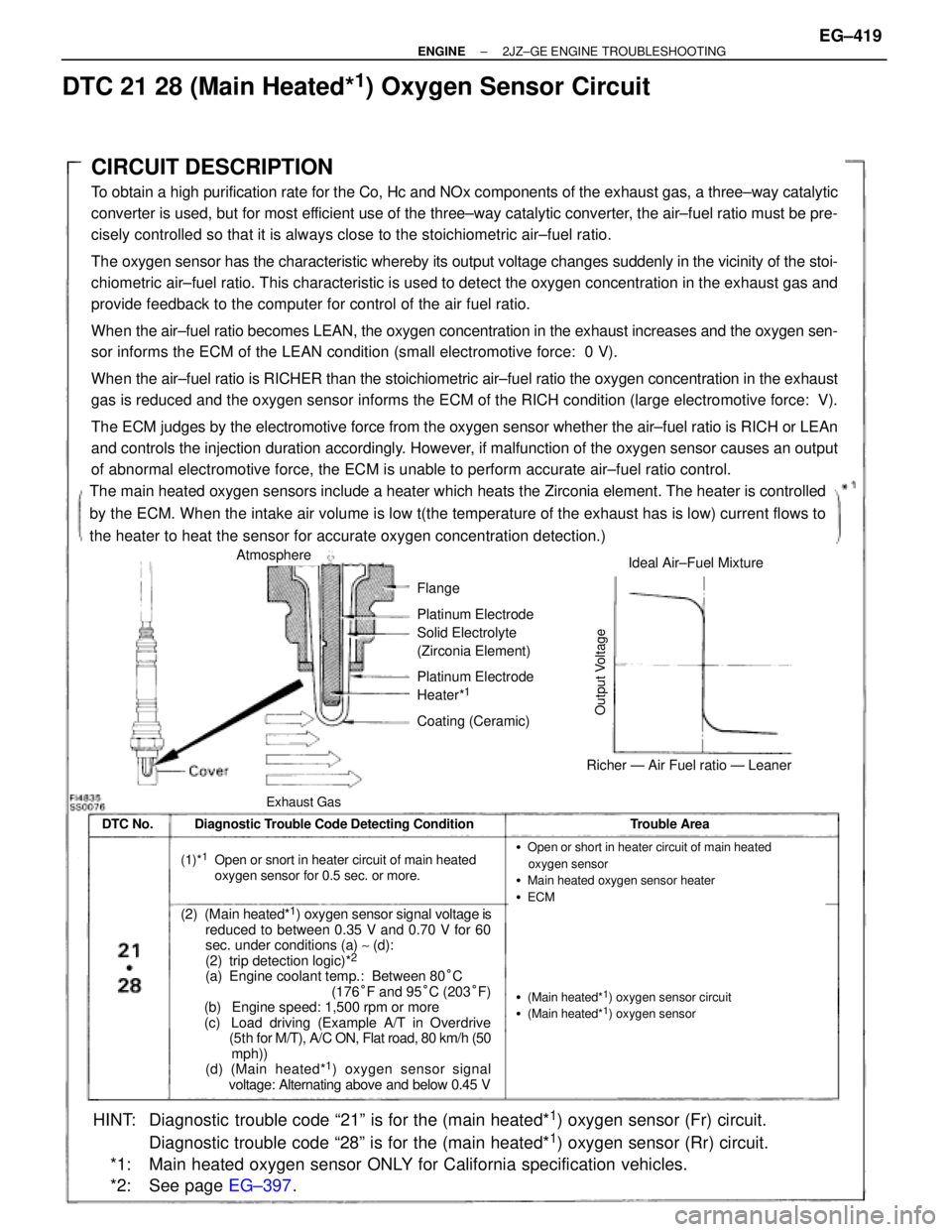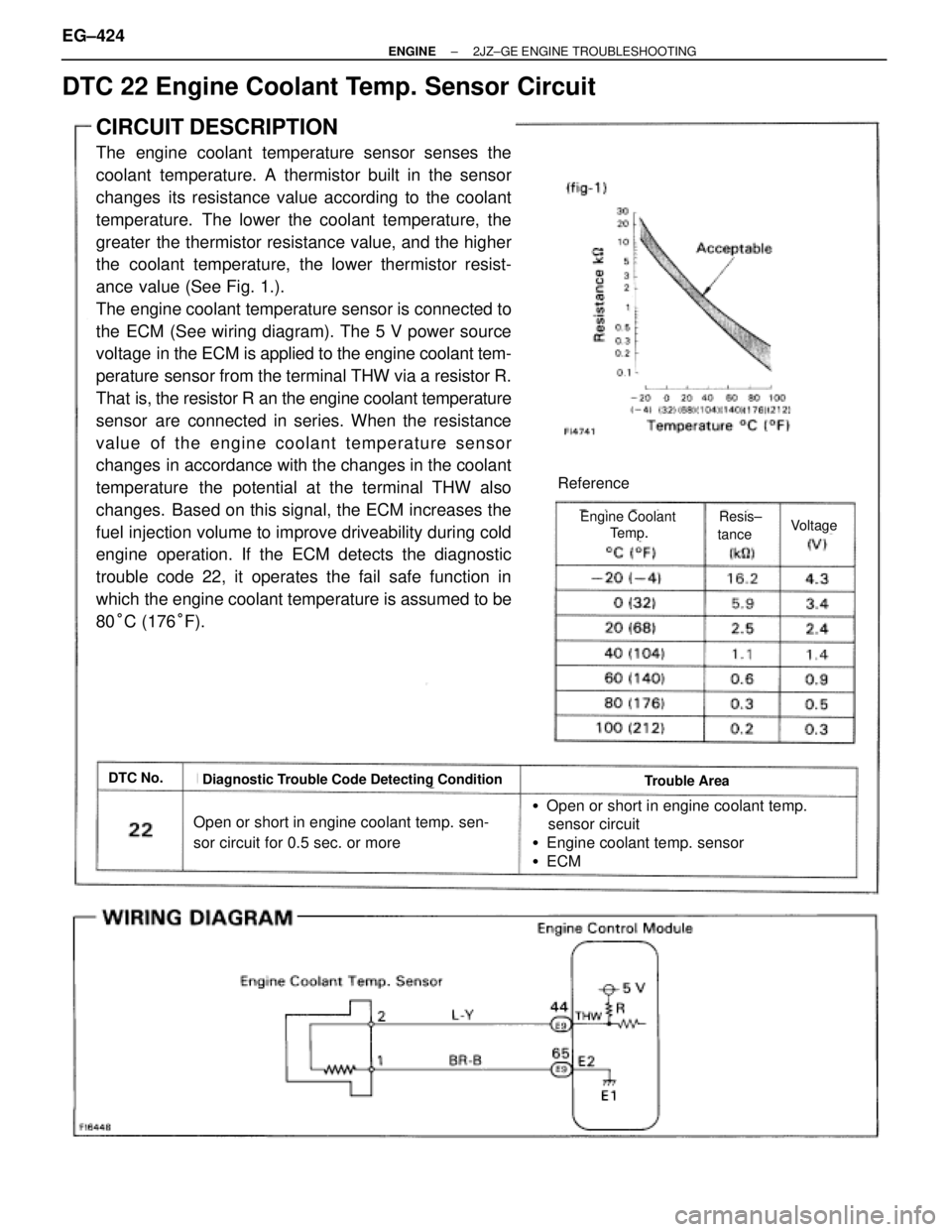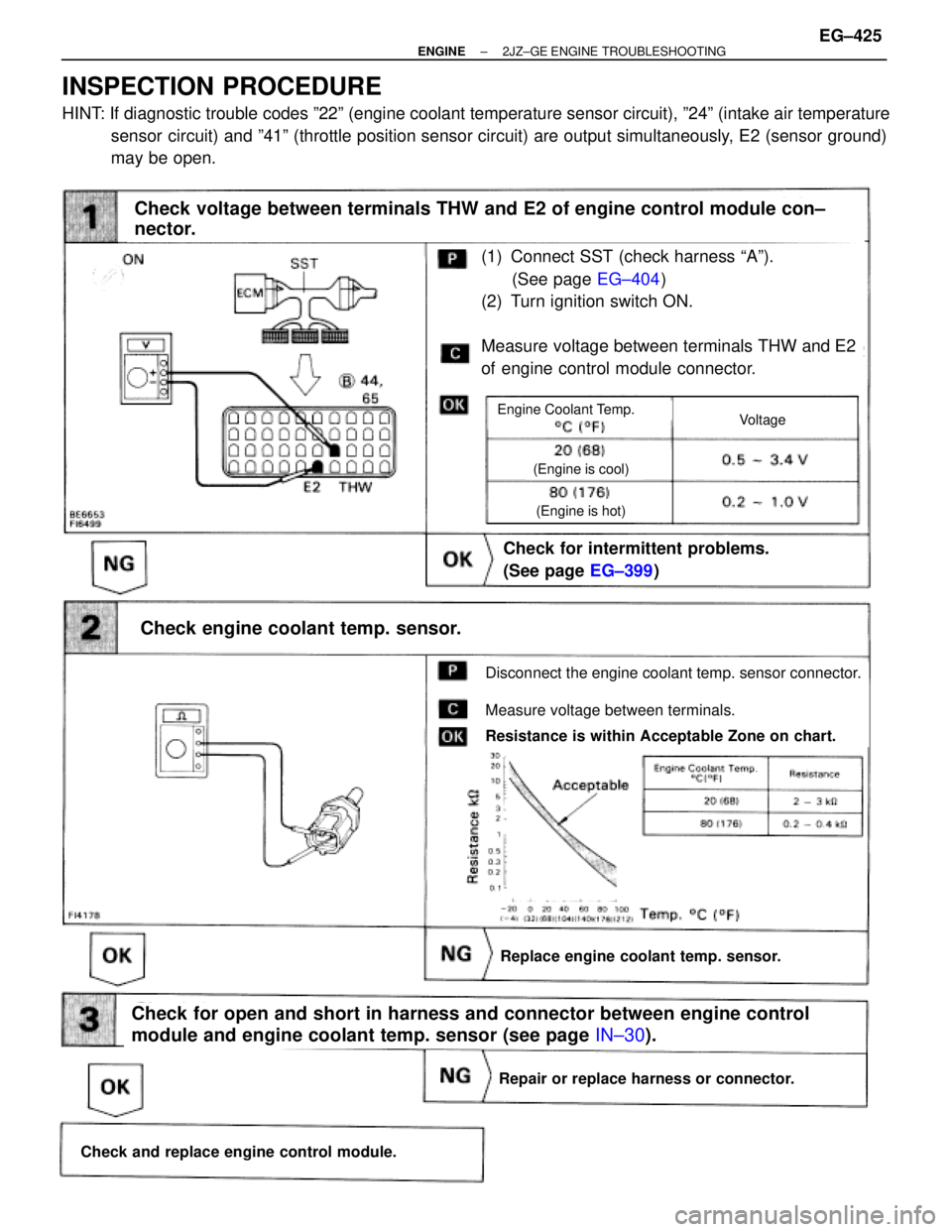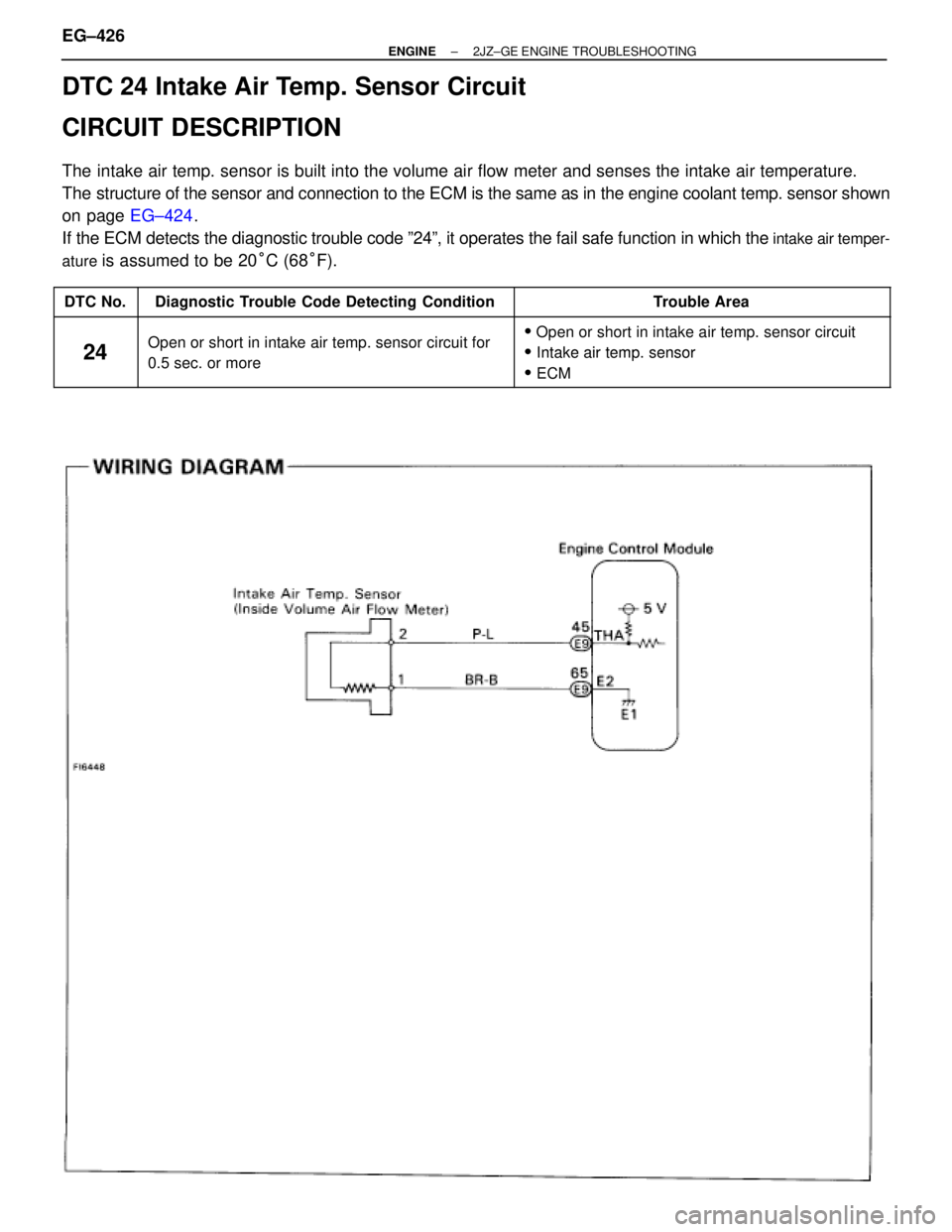Page 1927 of 2543

CIRCUIT DESCRIPTION
To obtain a high purification rate for the Co, Hc and NOx components of the exhaust gas, a three±way catalytic
converter is used, but for most efficient use of the three±way catalytic converter, the air±fuel ratio must be pre-
cisely controlled so that it is always close to the stoichiometric air±fuel ratio.
The oxygen sensor has the characteristic whereby its output voltage changes suddenly in the vicinity of the stoi-
chiometric air±fuel ratio. This characteristic is used to detect the oxygen concentration in the exhaust gas and
provide feedback to the computer for control of the air fuel ratio.
When the air±fuel ratio becomes LEAN, the oxygen concentration in the exhaust increases and the oxygen sen-
sor informs the ECM of the LEAN condition (small electromotive force: 0 V).
When the air±fuel ratio is RICHER than the stoichiometric air±fuel ratio the oxygen concentration in the exhaust
gas is reduced and the oxygen sensor informs the ECM of the RICH condition (large electromotive force: V).
The ECM judges by the electromotive force from the oxygen sensor whether the air±fuel ratio is RICH or LEAn
and controls the injection duration accordingly. However, if malfunction of the oxygen sensor causes an output
of abnormal electromotive force, the ECM is unable to perform accurate air±fuel ratio control.
The main heated oxygen sensors include a heater which heats the Zirconia element. The heater is controlled
by the ECM. When the intake air volume is low t(the temperature of the exhaust has is low) current flows to
the heater to heat the sensor for accurate oxygen concentration detection.)
Flange
Platinum Electrode
Solid Electrolyte
(Zirconia Element)
Platinum Electrode
Heater*
1
Coating (Ceramic)
Ideal Air±Fuel Mixture
Richer Ð Air Fuel ratio Ð Leaner
Trouble AreaDTC No.Diagnostic Trouble Code Detecting Condition
Exhaust Gas
Output Voltage
(1)*1Open or snort in heater circuit of main heated
oxygen sensor for 0.5 sec. or more.
(2) (Main heated*1) oxygen sensor signal voltage is
reduced to between 0.35 V and 0.70 V for 60
sec. under conditions (a) ~ (d):
(2) trip detection logic)*
2
(a) Engine coolant temp.: Between 80°C
(176°F and 95°C (203°F)
(b) Engine speed: 1,500 rpm or more
(c) Load driving (Example A/T in Overdrive
(5th for M/T), A/C ON, Flat road, 80 km/h (50
mph))
(d) (Main heated*
1) oxygen sensor signal
voltage: Alternating above and below 0.45 V
Atmosphere
�Open or short in heater circuit of main heated
oxygen sensor
�Main heated oxygen sensor heater
�ECM
�(Main heated*
1) oxygen sensor circuit
�(Main heated*1) oxygen sensor
HINT: Diagnostic trouble code ª21º is for the (main heated*1) oxygen sensor (Fr) circuit.
Diagnostic trouble code ª28º is for the (main heated*
1) oxygen sensor (Rr) circuit.
*1: Main heated oxygen sensor ONLY for California specification vehicles.
*2: See page EG±397.
DTC 21 28 (Main Heated*1) Oxygen Sensor Circuit
± ENGINE2JZ±GE ENGINE TROUBLESHOOTINGEG±419
Page 1928 of 2543

CIRCUIT DESCRIPTION (Cont'd)
DIAGNOSTIC TROUBLE CODE DETECTION DRIVING PATTERN
Purpose of the driving pattern.
(a) To simulate diagnostic trouble code detecting condition after diagnostic trouble code is recorded.
(b) To check that the malfunction is corrected when the repair is completed confirming that diagnostic
trouble code is no longer detected.
Malfunction: (Main heated() Oxygen Sensor Detection
(Vehicle Speed)
80 km/h (50 mph)
64 km/h (40 mph)
It is vital that this test routine is adhered to detect the malfunction:
(1) Disconnect the EFI No.1 fuse (30 A) for 10 sec. or more, with IG switch OFF. Initiate test
mode (Connect terminal TE2 and E1 of data link connector 2 with IG switch OFF).
(2) Start the engine and warm up with all ACC switched OFF.
(3) Idle the engine for 3 min.
(4) Accelerate gradually within the range 1,300 ~ 1,700 rpm (dentered around 1,500 rpm) with
the A/C switched ON and D position for A/T (5th for M/T).
HINT: �Ensure engine rpm does NOT fall below 1200 rpm.
�Gradually depress the accelerator pedal at a suitable rate to comply with the test
requirements on the above graph.
�Never allow engine rpm to drop at any time during the test.
(5) Maintain the vehicle speed at 64 Ð 80 km/h (40 Ð 50 mph).
(6) Keep the vehicle running for Ð 2 min. after starting acceleration.
HINT: If a malfunction exists, the Malfunction Indicator Lamp will light up after approx. 60 sec.
from the start of acceleration.
NOTICE: If the conditions in this test are not strictly followed, detection of the malfunction
will not be possible.
*: Main heated oxygen sensor only for California specification vehicles EG±420
± ENGINE2JZ±GE ENGINE TROUBLESHOOTING
Page 1929 of 2543
Replace oxygen sensor.
Go to relevant diagnostic trouble code chart.
Are there any other codes (besides code 21 or 28) being output?
WIRING DIAGRAM
INSPECTION PROCEDURE (Except California specification vehicles)
HINT: If diagnostic trouble code º21º is output, replace oxygen sensor (Fr).
If diagnostic trouble code º28º is output, replace oxygen sensor (Rr).
± ENGINE2JZ±GE ENGINE TROUBLESHOOTINGEG±421
Page 1930 of 2543
INSPECTION PROCEDURE (Only for California specification vehicles)
HINT: If diagnostic trouble code º21º is output, check the main heated oxygen sensor (Fr) circuit.
If diagnostic trouble code º28º is output, check the main heated oxygen sensor (Rr) circuit.
Check voltage between terminals HT1, HT2 of engine control module
connector and body ground.
Connect SST (check harness ªAº).
See page EG±404)
SST 09990±01000
Measure voltage between terminals HT1, HT2 of engine
control module connector and body ground.
Voltage: 9 Ð 14 V
Go to step
Check main heated oxygen sensor heater.
Disconnect main heated oxygen sensor connector.
Measure resistance between terminals 1 and 2 of main
heated oxygen sensor connector.
Resistance: 11 Ð 16 � at 20°C (68°F)
Replace main heated oxygen sensor.
Check and repair harness or connector between main
relay and main heated oxygen sensor, main heated oxy-
gen sensor and engine control module.
EG±422± ENGINE2JZ±GE ENGINE TROUBLESHOOTING
Page 1931 of 2543
Check voltage between terminals HT1, HT2 of engine control module
connector and body ground.
INSPECTION USING OSCILLOSCOPE
Replace main heated oxygen sensor.*
Check and replace engine control module.
*: It is probable the oxygen sensor has deteriorated.
Usually, this cannot be confirmed by visual inspec±
tion.
Warm up engine to normal operating temperature.
Measure voltage between terminals HT1, HT2 of
engine control module connector and body ground.
when engine is idling and racing at 4,000 rpm.
In the 4,000 rpm racing check, continue engine rac-
ing at 4,000 rpm for approx. 20 seconds or more.
�With the engine racing (4,000 rpm) measure wave±
form between terminals OX1, OX2 and E1 of engine
control module.
HINT: The correct waveform is as shown, oscillating be
tween approx. 0.1 V nd 0.9 V
If the oxygen sensor has deteriorated, the ampli±
tude of the voltage will be reduced as shown on the
left.
± ENGINE2JZ±GE ENGINE TROUBLESHOOTINGEG±423
Page 1932 of 2543

DTC 22 Engine Coolant Temp. Sensor Circuit
CIRCUIT DESCRIPTION
The engine coolant temperature sensor senses the
coolant temperature. A thermistor built in the sensor
changes its resistance value according to the coolant
temperature. The lower the coolant temperature, the
greater the thermistor resistance value, and the higher
the coolant temperature, the lower thermistor resist-
ance value (See Fig. 1.).
The engine coolant temperature sensor is connected to
the ECM (See wiring diagram). The 5 V power source
voltage in the ECM is applied to the engine coolant tem-
perature sensor from the terminal THW via a resistor R.
That is, the resistor R an the engine coolant temperature
sensor are connected in series. When the resistance
value of the engine coolant temperature sensor
changes in accordance with the changes in the coolant
temperature the potential at the terminal THW also
changes. Based on this signal, the ECM increases the
fuel injection volume to improve driveability during cold
engine operation. If the ECM detects the diagnostic
trouble code 22, it operates the fail safe function in
which the engine coolant temperature is assumed to be
80°C (176°F).
DTC No.Diagnostic Trouble Code Detecting ConditionTrouble Area
Open or short in engine coolant temp. sen-
sor circuit for 0.5 sec. or more
�Open or short in engine coolant temp.
sensor circuit
�Engine coolant temp. sensor
�ECM
Reference
VoltageEngine Coolant
Temp.
Resis±
tance
EG±424± ENGINE2JZ±GE ENGINE TROUBLESHOOTING
Page 1933 of 2543

(See page EG±404)
(1) Connect SST (check harness ªAº).
(See page EG±404)
(2) Turn ignition switch ON.
Measure voltage between terminals THW and E2
of engine control module connector.
Check for intermittent problems.
(See page EG±399)
Check engine coolant temp. sensor.
Replace engine coolant temp. sensor.
Repair or replace harness or connector.
Check and replace engine control module.
Check for open and short in harness and connector between engine control
module and engine coolant temp. sensor (see page IN±30).
Disconnect the engine coolant temp. sensor connector.
Measure voltage between terminals.
Resistance is within Acceptable Zone on chart.
Check voltage between terminals THW and E2 of engine control module con±
nector.
VoltageEngine Coolant Temp.
(Engine is cool)
(Engine is hot)
INSPECTION PROCEDURE
HINT: If diagnostic trouble codes º22º (engine coolant temperature sensor circuit), º24º (intake air temperature
sensor circuit) and º41º (throttle position sensor circuit) are output simultaneously, E2 (sensor ground)
may be open.
± ENGINE2JZ±GE ENGINE TROUBLESHOOTINGEG±425
Page 1934 of 2543

DTC 24 Intake Air Temp. Sensor Circuit
CIRCUIT DESCRIPTION
The intake air temp. sensor is built into the volume air flow meter and senses the intake air temperature.
The structure of the sensor and connection to the ECM is the same as in the engine coolant temp. sensor shown
on page EG±424.
If the ECM detects the diagnostic trouble code º24º, it operates the fail safe function in which the
intake air temper-
ature
is assumed to be 20°C (68°F).
���� �
��� ����DTC No.
����������������� �
���������������� �����������������Diagnostic Trouble Code Detecting Condition
����������������� �
���������������� �����������������Trouble Area
���� ����
24
����������������� �����������������Open or short in intake air temp. sensor circuit for����������������� ������������������ Open or short in intake air temp. sensor circuit
�Intake air tempsensor���� �
��� ����
24����������������� �
���������������� �����������������
Oen or short in intake air tem . sensor circuit for
0.5 sec. or more����������������� �
���������������� �����������������
� Intake air temp. sensor
� ECM
EG±426± ENGINE2JZ±GE ENGINE TROUBLESHOOTING